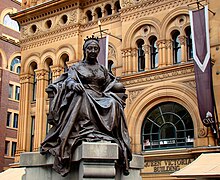Statue of Queen Victoria, Sydney

The seated Statue of Queen Victoria, currently in Sydney, New South Wales, Australia, was made by John Hughes in 1908 and was originally located in Dublin. Made of bronze, it is situated on the corner of Druitt and George Street in front of the Queen Victoria Building. It was the last royal statue to have been erected in Ireland.[1]
A standing bronze statue of Queen Victoria is located nearby, on

Sculpture
The statue shows an effort to portray Victoria Regina as the 'Irish Queen' rather than the 'British Sovereign'. She is seated in a low chair rather than an elaborate throne, allowing the artist to contain the figure within a sphere rather than as a towering pillar. (Other seated examples place her on a high throne.) And she wears a simple coronet rather than the royal or imperial crown...Moreover, the statue portrayed her as the Sovereign Head of the
The statue sat atop a
Location
Ireland
In 1922, 14 years after the statue's installation, Leinster House had become the seat of the Irish parliament, the Oireachtas, and nationalistic sentiment disapproved of having a British queen celebrated in such a location. The statue had by now been given the nickname "The auld bitch" by Irish writer James Joyce.[3][4][5] In August 1929 The Irish Times reported that discussions were under way to remove the statue “on the basis that its continued presence there is repugnant to national feeling, and that, from an artistic point of view, it disfigures the architectural beauty of the parliamentary buildings.”[2]
| External videos | |
|---|---|
Newsbeat by Cathal O’Shannon , RTÉ Television (13 January 1967). |
It was removed from its original location in July 1948 and replaced with a carpark.
The associated sculptures from the base of the statue are currently in the collection of Dublin Castle.[6]
Australia
In the mid-1980s, the iconic
The statue was transported by sea to Australia that year, restored in Sydney, and installed at its present location 43 years after it had last been on display. Despite heavy rain an unveiling ceremony took place on Sunday 20 December 1987 overseen by

A second statue nearby is of the Queen's favourite pet, a
See also
- List of statues of Queen Victoria
- Cloud Arch, a major proposed sculpture to be placed nearby
References
- ^ a b c d e f g Moore, Peter (2012). "Statue of Queen Victoria, Druitt Street". Dictionary of Sydney. Retrieved 24 July 2014.
- ^ a b c d e Fallon, Donal (7 July 2013). "Story of the statue in front of Sydney's Queen Victoria Building". Inside History. Retrieved 24 July 2014.
- ISBN 978-1405858434.
- ^ "World's Most Controversial Monuments (no.26)". Travel+Leisure. November 2011. Retrieved 28 July 2014.
- ^ "Queen Victoria Facts and Trivia". Queen Victoria Online. 2011. Retrieved 28 July 2014.
- ^ a b Fallon, Donal (24 May 2012). "Statues of Dublin: The unveiling (and removal) of Queen Victoria". Come here to me! Dublin life & culture. Retrieved 28 July 2014.
- ^ Catb (July 1977). "Royal Hospital, Kilmainham, Dublin". Flickr. Retrieved 29 July 2014.
- ^ a b c "QUEEN VICTORIA, QVB". Sydney Statues Project. 19 September 2010. Retrieved 29 July 2014.
- ISSN 0261-3077. Retrieved 17 January 2017.
- ^ ISSN 0261-3077. Retrieved 4 January 2018.
- Independent.ie. Retrieved 27 July 2014.
- ^ "The talking dog at the QVB". Time Out – Sydney. 4 June 2013. Archived from the original on 27 July 2014. Retrieved 24 July 2014.
